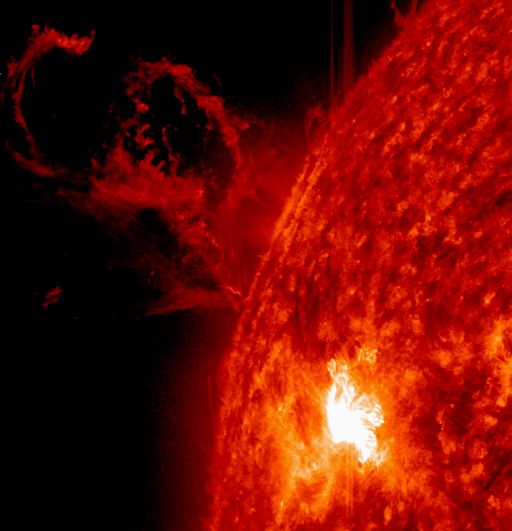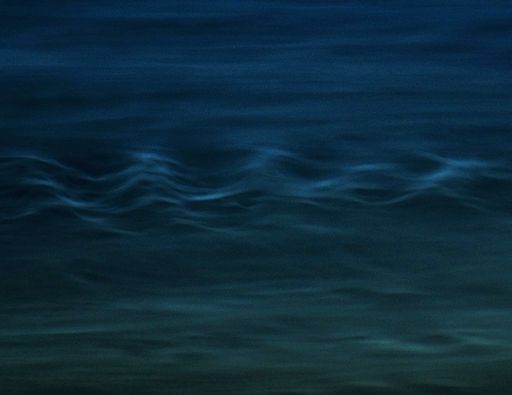Daily Suspicious0bserver's Weather Post:
July 9, 2014
What's in the sky tonight?
July 9, 2014
-Yesterday, July 8th, Earth-orbiting satellites detected a strong M6-class solar flare. NASA's Solar Dynamics Observatory recorded the extreme ultraviolet flash.
X-ray and UV radiation from the flare sent waves of ionization coursing through Earth's upper atmosphere. This briefly disturbed the propagation of shortwave radio transmissions around the dayside of our planet, especially over Europe and North America. Conditions have since returned to normal.
The flare came as little surprise. A phalanx of large sunspots is crossing the solar disk, and forecasters have been predicting an explosion for more than a week. However, the source of the flare was unexpected. It came from a minor and seemingly harmless sunspot named AR2113. Appearances notwithstanding, AR2113 has a 'beta-gamma' magnetic field that harbors energy for M-class solar flares.
With this flare, AR2113 joins two other sunspots capable of potent activity: AR2108 and AR2109. NOAA forecasters estimate a 75% chance of M-flares and a 20% chance of X-flares on July 9th.
 Astro Picture of the Day:
July 9, 2014
Source:
Astro Picture of the Day:
July 9, 2014
Source:
This planet is only 16 light years away -- could it harbor life? Recently discovered exoplanet Gliese 832c has been found in a close orbit around a star that is less bright than our Sun. An interesting coincidence, however, is that Gliese 832c receives just about the same average flux from its parent star as does the Earth. Since the planet was discovered only by a slight wobble in its parent star's motion, the above illustration is just an artistic guess of the planet's appearance -- much remains unknown about Gliese 832c's true mass, size, and atmosphere. If Gliese 832c has an atmosphere like Earth, it may be a super-Earth undergoing strong seasons but capable of supporting life. Alternatively, if Gliese 832c has a thick atmosphere like Venus, it may be a super-Venus and so unlikely to support life as we know it. The close 16-light year distance makes the Gliese 832 planetary system currently the nearest to Earth that could potentially support life. The proximity of the Gliese 832 system therefore lends itself to more detailed future examination and, in the most spectacularly optimistic scenario, actual communication -- were intelligent life found there.
Daily Suspicious0bserver's Weather Post:
July 10, 2014
What's in the sky tonight?
July 10, 2014
-Vega is the brightest star very high in the east these evenings. The brightest to its lower left is Deneb. Farther to Vega's lower right is Altair. These make up the big Summer Triangle.
-Solar activity is low, but the quiet is unlikely to persist. There are three sunspots with unstable magnetic fields capable of strong eruptions: AR2108, AR2109, AR2113. NOAA forecasters estimate a 75% chance of M-flares and 15% chance of X-flares on July 10th.
-After weeks of sightings over Europe, noctilucent clouds (NLCs) are spreading to North America. "A spectacular display emerged over the Edmonton area on July 8/9," reports Canadian photographer Mark Zalcik. "For awhile there were multiple zones of billow-type NLC, including the snake-like one in this photo."
 Astro Picture of the Day:
July 10, 2014
Source:
Astro Picture of the Day:
July 10, 2014
Source:
This scene from the early morning hours of July 3 looks out across the River Thames from the Westminster Bridge. Part of a luminous timelapse video (vimeo), the frame captures a sight familiar in London, the nighttime glow of the London Eye. But a not-so-familiar sight is shining in the still dark sky above, widespread noctilucent clouds. From the edge of space, about 80 kilometers above Earth's surface, the icy clouds can still reflect sunlight even though the Sun itself is below the horizon as seen from the ground. Usually spotted at high latitudes in summer months the diaphanous apparitions are also known as polar mesospheric clouds. The seasonal clouds are understood to form as water vapor driven into the cold upper atmosphere condenses on the fine dust particles supplied by disintegrating meteors or volcanic ash. NASA's AIM mission provides daily projections of the noctilucent clouds as seen from space.